Over the last few years, I’ve really learned the value of high-quality pans. Before, I cooked with cheap-o pans, often buying the cheapest ones I could, valuing price over quality.
I was foolish to believe that the price tag was more related to how stylish the pan was or because it was a particular brand—not because it could drastically improve a meal.
Not only did these cheap pans not last long, but when I finally got around to using quality skillets, I saw how much better they are when cooking.
The transfer of heat is different and that completely changes how your food is cooked. It changes the taste and texture.
This pre-seasoned cast iron pan is ideal for searing, sautéing, frying, baking, and roasting meats and vegetables at home, and can be used on the stovetop, in the oven, on the grill, and even over a campfire. Look after it well and it will serve you for a lifetime.
In this article, I’ll review the 10.25″ (26cm) ‘Seasoned Cast Iron Dual Handle Pan’ (model No.: L8SKL) as much as is humanly possible, coving every inch.
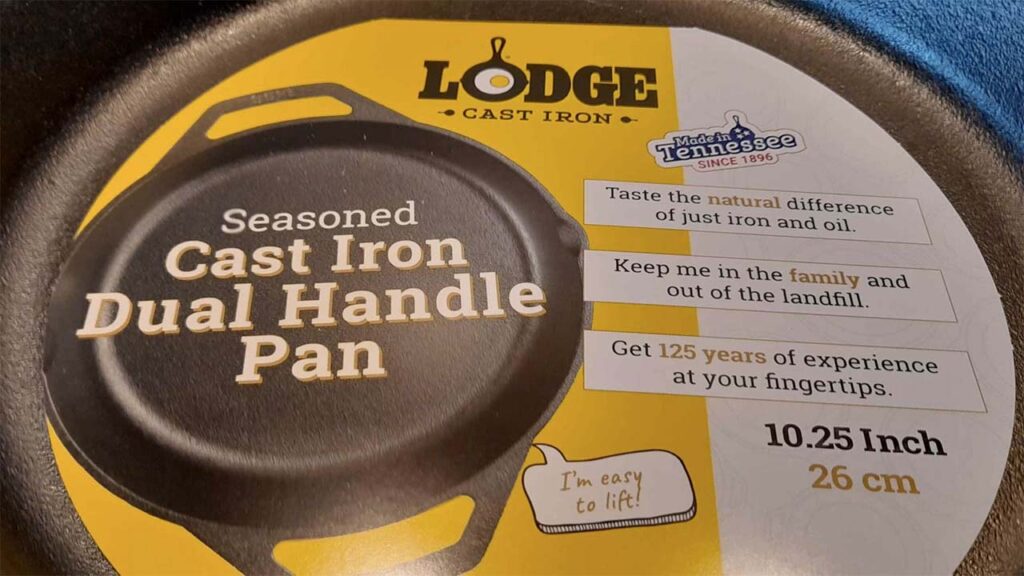
While this review is not for the version of this pan with a single handle, you may still find it useful.
Full disclosure, this is the first-ever cast iron skillet I have owned.
Is Lodge a Good Brand for Cast Iron Skillets? A Brief History
Lodge, or Lodge Cast Iron, was founded by Joseph Lodge in 1896 in Tennessee and claims to be “America’s oldest manufacturer of cast iron cookware” according to LinkedIn.
126 years later, Lodge is still a family-owned company, and they remain in Tennessee, operating out of South Pittsburg.
The company has a long history of producing high-quality cast iron products with their cookware, particularly their skillets, garnering them a strong reputation.
If you’re looking for an American-made product, Lodge Cast Iron is hard to beat. Lodge produces its skillets the old-fashioned way in foundries.
Buying an American-made cast iron skillet is as original as buying French champagne—you know it’s authentic and does the job as intended.
You can find out more about the history of Lodge here.
What Is So Special About Lodge Cast Iron Skillets?
This skillet comes pre-seasoned with vegetable oil for easy use out of the box. They can be used on all cooking surfaces, including induction, grill, oven, and even on the campfire.
Weight
This skillet was heavier than I expected. Mine weighed in at approximately 5.73lbs (2.6kg).
Careful using this skillet on a glass hob as its weight can make it easy to scratch the surface. Though Lodge says that it’s safe to use, you can still get scratches.
It’s up to you to move it as little as possible. If you have to move it, pick it up, which will mean you’ll again need oven mitts.
Dimensions
The pan is a pretty decent size and it’ll fit nicely in most kitchens, cabinets, and other storage. You likely won’t have a problem with its size (not unless you want a larger skillet).
- Rim to rim: 10.25″ (26cm)
- Handles: 1.37″ (3.5cm)
- Handles width: 5.7″ (14.5cm)
- Width handle to handle: 12.7″ (32.5cm)
- Pouring lip width: 1.3″ (3.5cm)
- Width pouring lip to pouring lip: 10.7″ (27.2cm)
- Depth: 2″ (5cm)
- Base: 9″ (22.8cm)
Note that these measurements are approximate (I can make mistakes!), and there may be discrepancies between skillets.
Reading Materials
The marketing materials come with a few useful things. Perhaps one of the best to remember is the model, L8SKL, which you might need if you need to return the product or want more info.
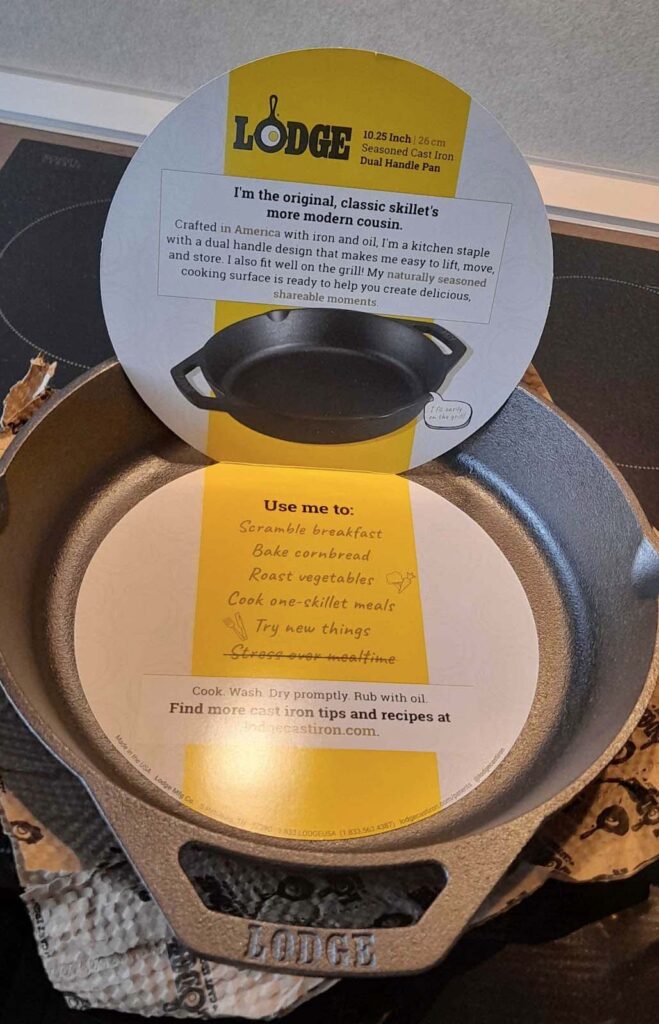
It also comes with a few suggestions for how to best use the skillet, which is useful for people like me who haven’t used a pre-seasoned cast iron skillet before.
The list includes:
- Scramble breakfast.
- Bake cornbread.
- Roast vegetables.
- Cook one-skillet meals.
And at the back, it has some useful advice, “After each meal, hand wash your cookware, dry promptly, and apply a thin layer of cooking oil to the entire surface.”

The Handles
The handles are made of metal like the rest of the pan. This means you’ll be able to stick it in the oven, but you’ll need oven mitts to hold the handles.
One handle says ‘LODGE,’ and the other says ‘1896’—the founding year.

Both are wide enough for me to fit all four fingers through, though, if it’s hot and you’re wearing oven mitts, you won’t be able to hold the pan this way.
Either handle can be used to hang the skillet on the wall.
The Base
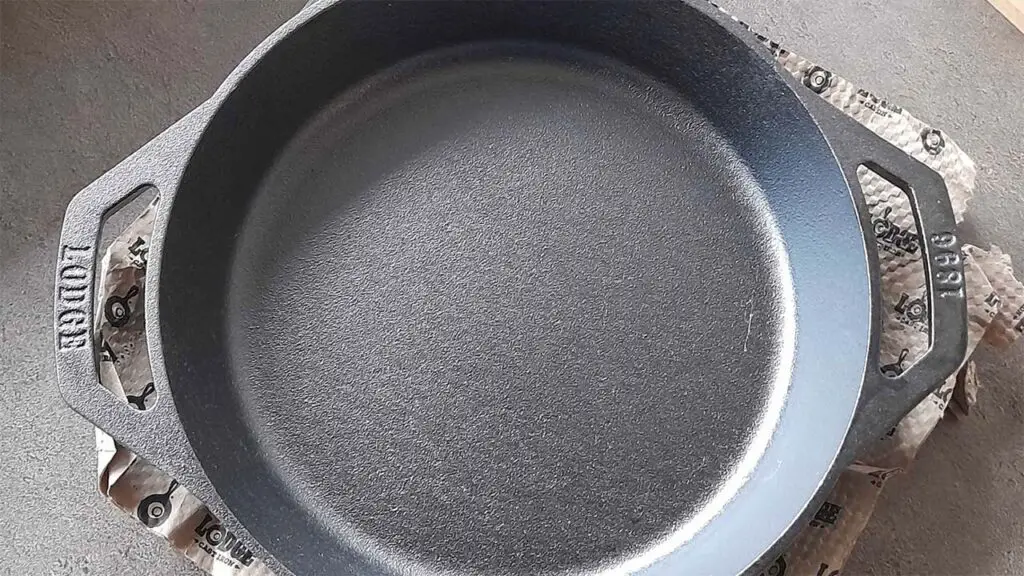
The base of the pan is rather flat, maximizing the amount of space for cooking.
Because of this, it stops oil from pooling around the edges of the pan which has been a pain point for me on other pans I’ve used before.

Other Features
What I also liked was that the skillet had two pouring lips, one at each side, which is really useful if you need to pour out any excess liquids.
Other than that, I really appreciated the height of the sides. When frying, it makes it not very likely that anything is going to slip out, and means you can make larger meals in the oven.
Why Is Lodge Cast Iron So Cheap?
One of the first things you might notice when considering a Lodge skillet is how strangely cheap they are.
You would really think that such a reputable brand would jack the prices up a bit more, but no.
Sharon Franke of the Kitchn spoke to Lodge Cast Iron CEO Mike Otterman who explained why Lodge is so cheap.
The first thing they noted was that the pans aren’t ‘complicated to make,’ which makes a lot of sense.
Lodge’s About Us page explains the process simply, “We pour a mix of molten iron and steel into sand molds to create solid, durable pieces of cookware that will last for generations.”
Next, they said that the fact their skillets are produced locally also helps massively with the price. Shipping heavy skillets from factories abroad can be costly.
At the time of writing, a 10″ pre-seasoned Lodge skillet can cost as low as $19.90 at Amazon. Outside the USA (and likely North America), Lodge is not so cheap.
The same 10″ Lodge skillet costs £44.99 on Amazon’s UK site—that’s roughly $54.10 at the time of writing, twice the price.
The last factor they mentioned was limited packaging, which I can confirm to be true. (To be honest, with such a tough product, any more packaging would be pointless.)
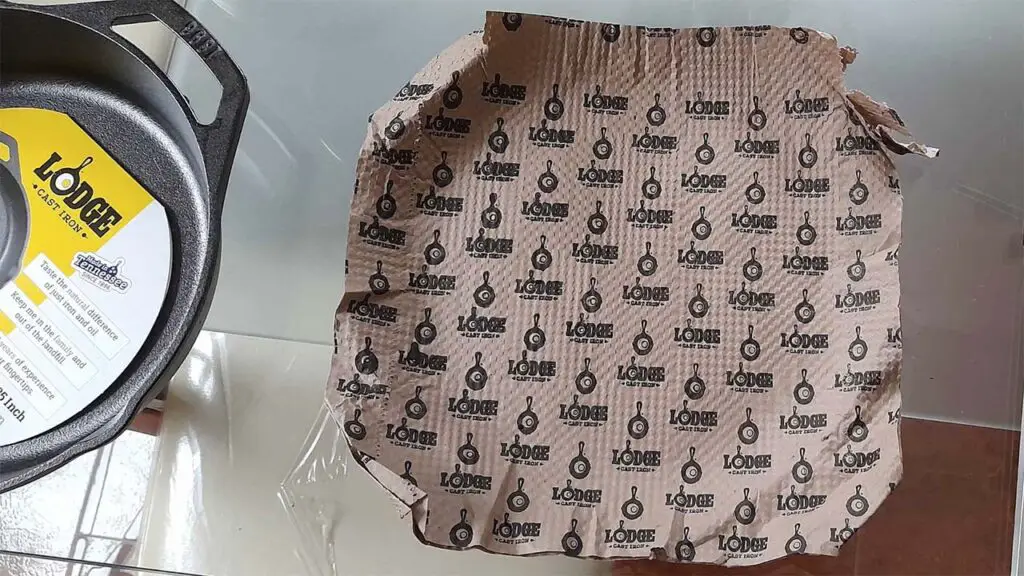
Pros and Cons of Lodge Cast Iron Skillets
Pros:
- Versatile. You can use this skillet in a wide variety of ways—in the oven, on the hob, out camping, or on the grill.
- Durable. This skillet is very tough—it’ll probably outlive me; I might even leave it to the future grandkids in my will!
- Heat performance. Arguably the No. 1 reason you’re considering a Lodge cast iron skillet.
- Reputable brand. Lodge Cast Iron is one of the best-known brands for cast iron skillets.
Cons:
- Heavy. This is one of the heaviest pans I’ve ever owned, but this is something you can get used to with time.
- Requires maintenance. However, this might not be a big deal if you don’t use it too frequently and save it for special occasions.
The two above are rather minor issues. The biggest issue I have with this skillet needs more than just a bullet point to go through—defects.
It wasn’t until I was halfway through this review (literally about to test it on the hob) did I notice two strange issues.
The first and less important of the two was what looked like grooves around the handles, possibly made during the manufacturing process. That’s not that bad, I can live with that.

The second and more serious issue was what looked like exposed metal on one of the handles as if it had been chipped off, and it had me a little concerned.
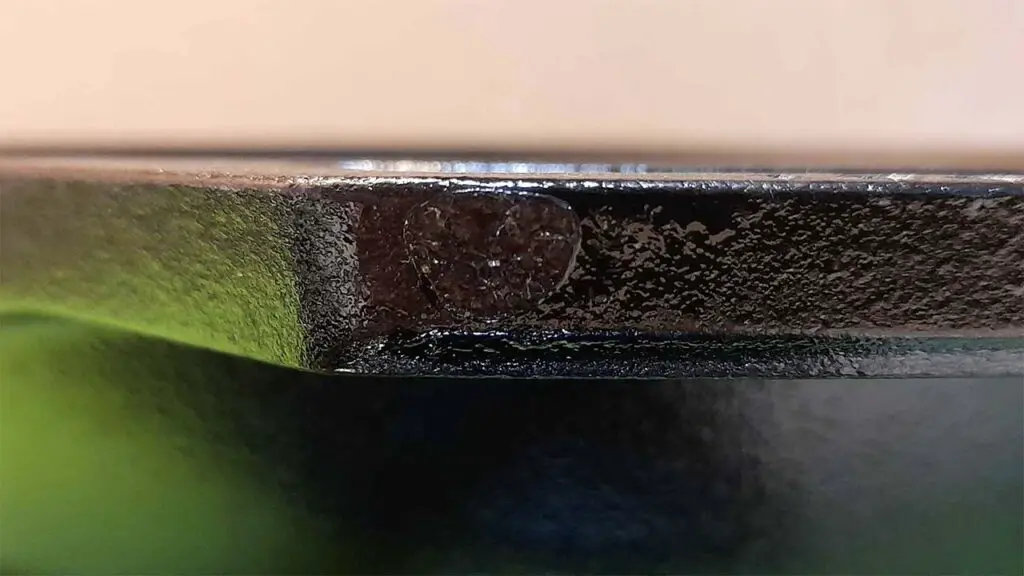
Could this mean that this skillet would be more prone to rust? Could this gap grow and spread to other parts of the pan? Would it be prone to heat changes?
Of course, there’s always the chance that it could have been damaged on delivery, but it did have me wondering about the longevity of the pan.
And while researching some of Lodge’s skillets, I did notice that others had had similar complaints when ordering from Amazon.
Despite this, in my opinion, the pros outweigh the cons and having a Lodge cast iron skillet is still a huge plus to any kitchen.
Do note, that many of the pros can be appropriated to other cast iron skillets too. So, if your budget is a little short, you may be able to find something of similar quality elsewhere.
How to Use Your Lodge Cast Iron Skillet for the First Time?
You can use a cast iron skillet in quite a few ways and Lodge is no different. I decided to give the pan an easy test for its first run—steaks. Here’s what I did.
First, I removed the packaging and marketing materials. Thankfully, there’s not much of it aside from the protective paper at the bottom and the marketing materials on the inside.
Then I rinsed the skillet, not just because you should anyway but because the marketing materials were glued to the inside, which to be honest was a bit of a surprise.
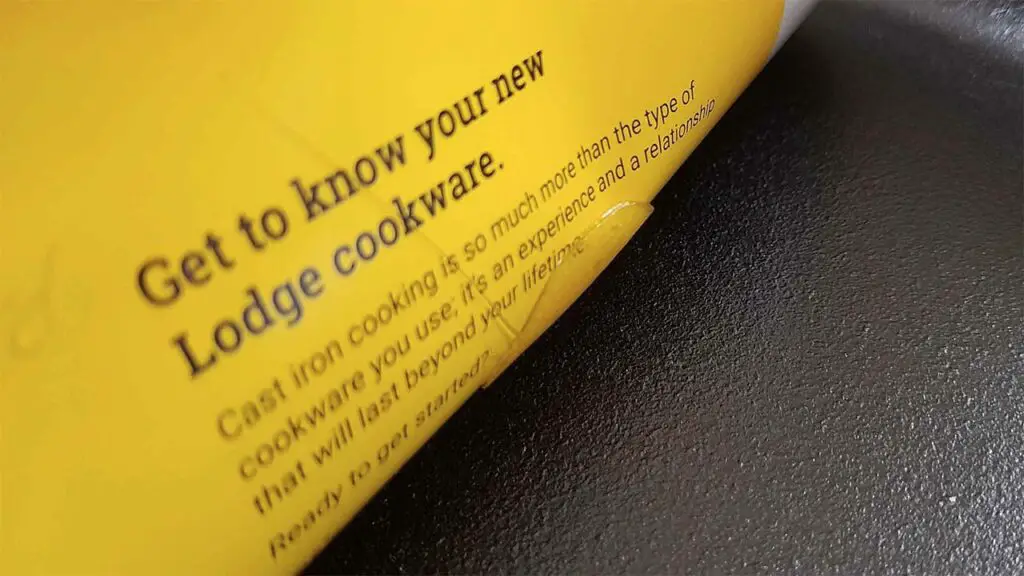
I’ve been told a few times not to use soap, or if I did, not too much. For foodstuffs, I have no problem with that, but chemicals like glue made me feel uneasy.
Thankfully though, it rolled off with ease, so I believe it was gummy glue and likely didn’t leave any residue.
After rinsing, I seasoned the pork steaks with salt and black pepper and began to heat the pan.
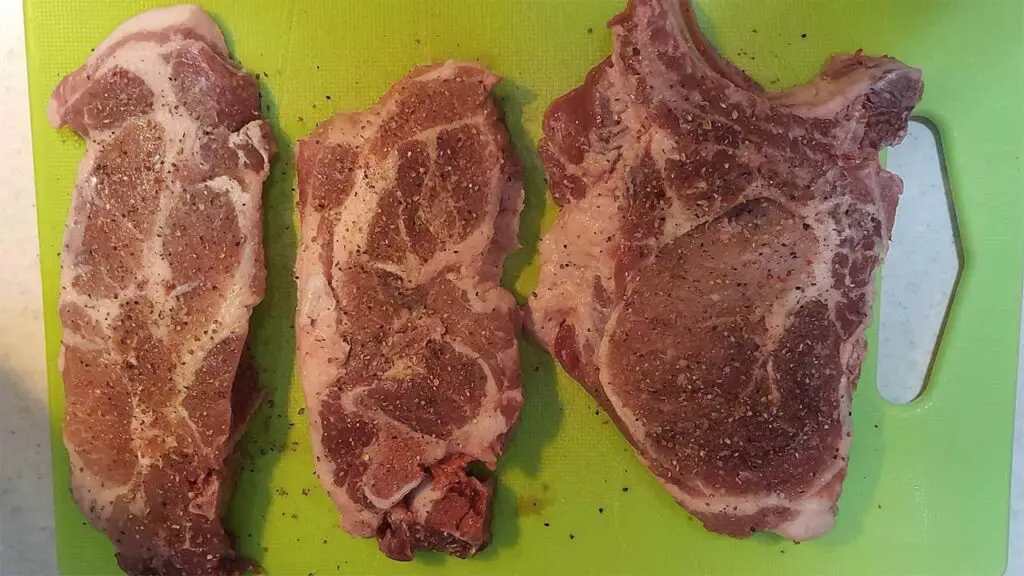
I have an electric hob and know that it should be heated slowly at low heat, so out of the temperature range of 1 to 9 settings, I started out on 4.
Next was oil.
Lodge Cast Iron says that you can use whatever oil you prefer, adding “Olive oil, vegetable oil, sunflower oil, and grapeseed oil are all great multipurpose cooking oils.”
I used two tablespoons of sunflower oil. After a few minutes, when I saw that the heat had started to take effect on the oil, I turned it up to 7, and 5-10 minutes later added the steaks.
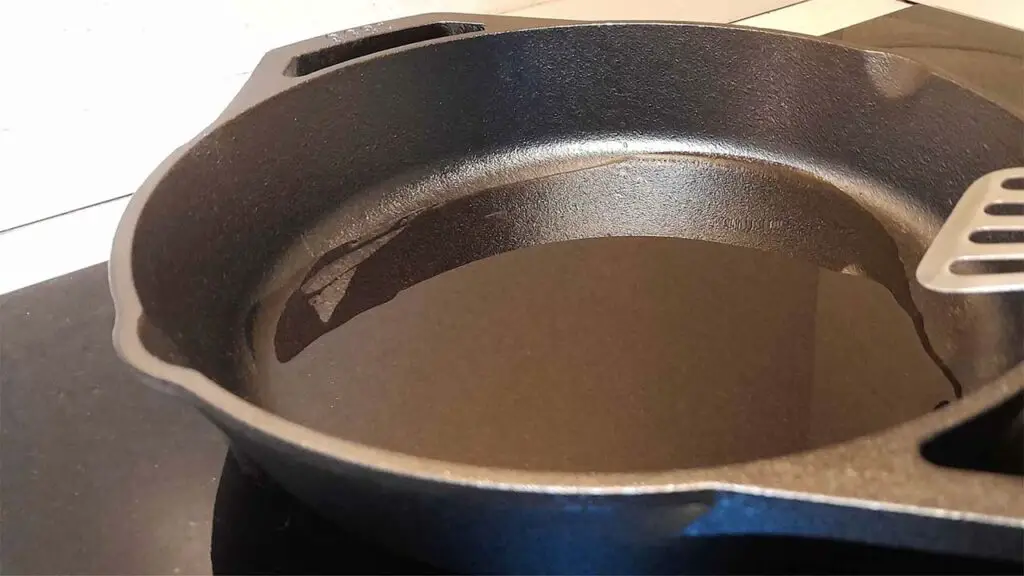
I realized two things at this point.
First, be careful not to touch the sides of the pan with the meat when hot. The edges of the steaks immediately stuck to the sides of the pan, and I had to move them away.
What I learned from this is to either avoid the sides or add a bit of oil there too to prevent this from happening.

The second was that I misjudged how much space I had to cook. I assumed that I could fit three steaks, but only two fit. (My mistake!)
So, not to waste the third, I decided to cook it in another pan and compare the results.
After five or so minutes, I flipped the steaks and was pretty impressed by the browning and caramelization of the meat. No burning at all.
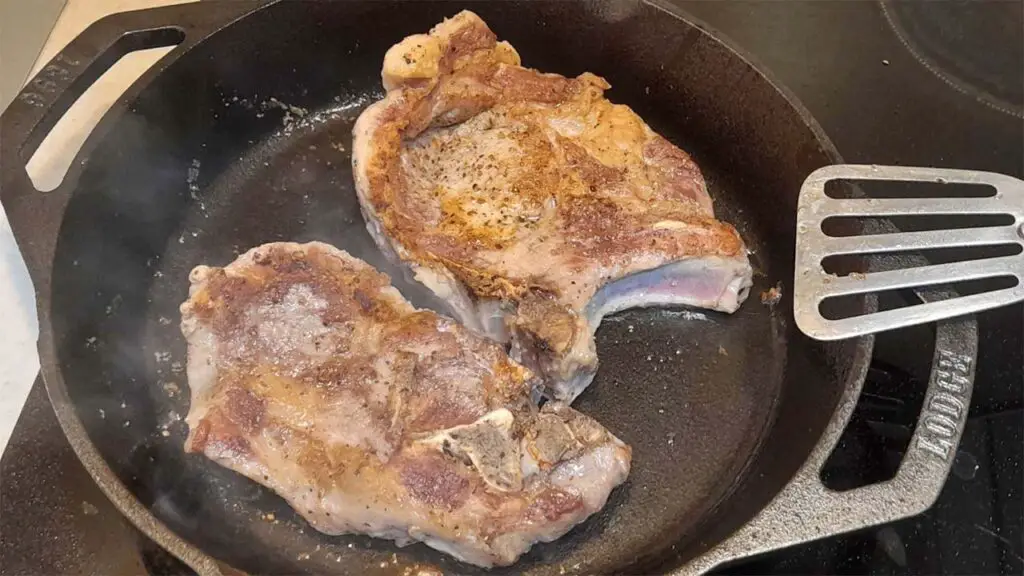
It’s also worth noting that although I was cautious to move the skillet on the glass hob without picking it up, I actually found that small gentle nudges were fine.
My conclusion about this warning is that you should be cautious not to move it too much, too fast, or be too rough with the pan when cooking on glass.
Then, after I had done both sides, I decided to see what would happen if I put the pan in the oven which I had preheated earlier at around 350°F (176°C).
It was at this point I realized that two tablespoons of oil were too much—one was definitely enough. This was because every time I opened the oven, it was pretty smoky.
Further to that, a fair amount of oil was spat out when on the hob. Lesson learned for next time!
Taking the pan out of the oven, the meat looked perfect.
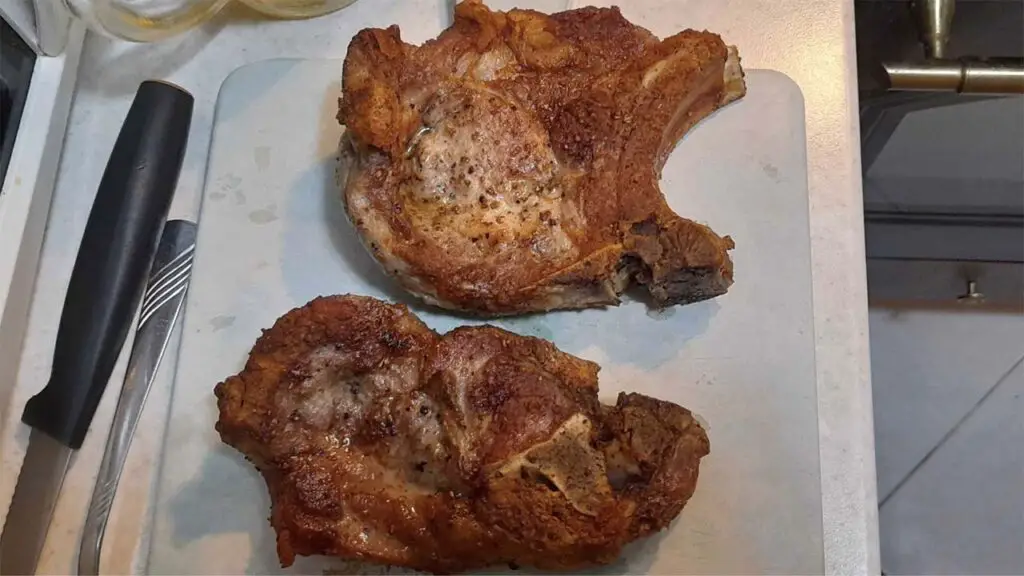
And lastly, before eating, I placed the skillet to the side on the hob to cool down safely, and where I would clean it a little later.
On the taste test, I was super happy with the results, slightly crunchy on the outside, nicely tender on the inside, and retaining a nice deal of moisture.
100% improvement on the third steak using my old pan.
How to Clean and Maintain Lodge Cast Iron Skillets
You will need to do two things to keep your lodge cast iron skillet tough and performing at its best—clean it properly, and season it.
I left the pan for a while, at least 20 to 30 minutes to cool down, checking on it every so often to see how hot it was.

When it was cool enough, I gently rinsed away the oil and then washed the pan with a sponge using a little dish soap.
Remember how I mentioned earlier that some of my steaks touched the sides when frying? There were a few marks left over afterward and they were super tough to try to remove.
Once I was satisfied it was clean enough, I gently dried away all the drops of water with a towel, put a bit of oil on a napkin, and lightly rubbed it and it was done.
Funnily enough, the more you use this skillet, the tougher and better maintained it can become, though, it can depend on what you cook.
The last section of the marketing materials says, “there are some great foods that strengthen your base layer of seasoning when new, such as bacon, hamburger, and roasting vegetables with oil.”
So, these are definitely on my list to try next.
The Verdict
I’m a proud owner of this skillet and I really can’t wait to put it to the test and grill several things at once when the spring weather arrives.
At first, the idea of properly maintaining this skillet was a little intimidating. If I get it wrong, am I going to ruin it? But after my first use, those worries are gone.
If you buy this skillet, do make sure to look out for defects. Mine were likely minimal, but if you get this pan and you’re concerned about them, see if you can get a new pan.
Though Lodge boasts about the durability and strength of their pans, evidently there are issues here and there and they should be addressed.
Purchasing a Lodge cast iron skillet is an investment for two reasons:
- It’ll outlive all the other pans you have if you properly maintain it. You could actually save money because you won’t need to replace your skillets so often.
- You’re going to love the food you cook. If you’ve never cooked with a cast iron skillet before, you’ll notice a big difference in quality.
Where to Buy
This pre-seasoned cast iron pan is ideal for searing, sautéing, frying, baking, and roasting meats and vegetables at home, and can be used on the stovetop, in the oven, on the grill, and even over a campfire. Look after it well and it will serve you for a lifetime.



